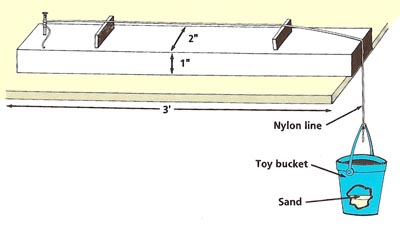SOUNDS INTERESTING: The Science of Acoustics - 2. Sounds Different

Figure 1. Rock concert.

Figure 2. Plucked string experiment.
Listen to a piece of your favorite music and notice how the sound changes from one moment to the next (see Figure 1). As well as going from loud to soft, it also varies in pitch. Pitch is the highness of lowness of a sound. A bass guitar, for instance, makes notes of a very low pitch. A lead guitar, on the other hand, can play a wider range from low to very high notes.
The pitch of a sound depends on how quickly the source of the sound is vibrating. The faster the vibrations, the higher the sound.

Higher and HigherYou will need:
What to do: Hammer the nail firmly into one end of the large piece of wood. Tie one end of the fishing line to the nail. Place the wood on a table and pull the fishing line over the wood so that it hangs over the side of the table. Tie the bucket to the end of the line. Place the two small pieces of wood under the line as shown. Pluck the line and listen to the note (see Figure 2). Put some sand in the bucket and pluck the line again. Is the note higher, lower, or the same? Add some more sand. Has the pitch gone up or down?
Without changing the amount of sand in the bucket, move the two small pieces of wood closer together. What happens to the pitch? Can you explain your findings?
Taking it further: You will need the help of someone who can play an instrument (such as a piano, recorder, or guitar). The instrument must be in tune.
Begin by tuning the nylon line to a particular note. Do this by putting a bit of sand in the bucket and then moving one of the small pieces of wood until the note made by the line matches a note on the instrument. Weigh the bucket and sand. Record this weight and the note sounded by the instrument (for example, C or F sharp). Next, add enough sand for the string to make a note one semitone higher. For example, if the starting note was D, then the next note should be D sharp. If you are not sure how to do this, ask the help of someone who can read music. Weigh this bucket and sand again. Repeat this until you have a list of about ten notes and the corresponding weights. Plot your results on a graph. What shape is the curve?
This experiment, and several others in this on-line book, will be simpler to carry out if you have access to a sound frequency meter. This is an instrument that automatically displays the frequency of a note. With a frequency meter, you can measure directly the frequency of sound produced by the stretched line each time you increase the load hanging from it.
Try repeating the experiment with a nylon line of a different thickness. Is the curve you obtain the same? |
Wave after Wave
The rate at which a sound wave goes back and forth is called the FREQUENCY. It is measured in the number of vibrations per second, or HERTZ. (The German scientist Heinrich Hertz, after which the unit of frequency is named, did a lot of work in the science of waves).
For example, is a string vibrates 250 times a second it gives to a sound wave with a frequency of 250 hertz. An object that vibrates 1,350 times a second produces sound with a frequency of 1,350 hertz, and so on.
If a string of a certain length is stretched tighter it will vibrate faster, producing sound of a higher frequency. Can you suggest a reason why humans and other animals can vary the frequency of the sounds they make?
Probing with Ultrasound
Sound that is too high for humans to hear is known as ultrasound. It has a number of important uses, one of which is the ultrasound scanner. Using this, a doctor can watch a moving television picture of an unborn baby inside its mother. The scanner sends out a beam of ultrasound into the mother's body. It then picks up the echoes that come back from the baby. The returning signals are used to build up a picture on a television screen. Not only does the reflected ultrasound beam show the outline of the whole baby but it also shows details inside the baby such as its beating heart. In this way, the doctor can check if all is well and whether, for example, the mother is carrying one baby or two.
Industries also make use of ultrasound. A beam of ultrasound can check metal parts, such as those of an aircraft, to see if they contain any tiny cracks. More powerful beams can cause materials to vibrate so much that they heat up and melt. Ultrasonic welding machines are used to weld plastic parts together.

